Snipers around the planet and Barrett firearms, along with programmatic inertia from U.S. Special Operations Command, are all pushing the limits of just how far a shooter can put a bullet accurately into a target.
Every year, there is a special event at the NRA Whittington Center in Raton, New Mexico known as the “King of Two Miles” competition, a highly watched and respected event in the long-range and extreme long-range shooting community. There are strict rules. The team is a shooter and his spotter. Anyone with shooting experience knows that teamwork is a critical aspect of long-range shooting. The rifle must weigh under 40 pounds and one man must be able to carry the rifle, spotting scope, and any needed gear to the line. It’s prone rifle shooting with a bipod that has one attachment point to the rifle and two points on the ground. Period.
The 416 Barrett cartridge has won King of Two Miles three times. The first year, 2015, and then in 2018 and 2019, matching the 375 Cheytac wins. 416 Barrett is an excellent extreme long-range cartridge, and this year, while Josh Silby and spotter Eric Owen took “King” with an Alamo Precision rifle in 375 Cheytac, the “Prince” (second place) was Justin Wolf and spotter James Archer using the new Barrett MRADELR (MRAD Extreme Long Range) rifle chambered in 416 Barrett.
The MRADELR is an easily man-deployable sniper rifle, not a benchrest-type rifle, and placing second is a huge accomplishment for a rifle in its first year of production. It means the team and equipment delivered solid hits at two miles, a capability the U.S. (and its allies) sniper community is searching for.
The 416 Barrett cartridge was designed by Chris Barrett with assistance from his father Ronnie and the Barrett Firearms engineering team. The end goal was to achieve solid 2,500m accuracy with a 470-grain projectile. There is a misconception that this cartridge was designed to get around California’s 50 BMG rifle ban, but that’s just a bonus side effect. The real meat of cartridge is its long-range performance, and, as noted, there have been serious two-mile contests won with this cartridge.
SOCOM has been looking for the extreme long range sniper rifle system to outperform the MK22 Mod 0 in 338 Norma Magnum. To the point, they want to reach out further. Barrett’s system of the MRADELR is a perfect fit, but there are parallel caliber developments in the government view. The Barrett MRADELR, with the 416 Barrett cartridge, is clearly in the running for the new program.
We had the opportunity to test the MRADELR over the last few months. It has turned out to be very accurate, reliable, easy to work with, and since there is no system of long-range shooting accessories dictated by the company or a government contract yet, we built our own suite of tools to exact the best performance from the rifle and cartridge. This is photo essay for you, the reader, to follow our journey with the MRADELR.

MRADELR SPECS
Caliber 416 Barrett
Operation Bolt Action Repeater
Barrel Length 36 in. (914mm) (There is a shorter suppressor barrel to be offered)
Barrel Twist Rate 1:9 in. (1:229mm)
Overall Length 62 in. (1575mm)
Weight 23.0 lb. (10.4 kg) w/empty mag, no accessories
Magazine Capacity 5 rounds
Rail Length 24.63 in. (626mm)
Rail Angle 10 MOA
Colors Cerakote Black, Flat Dark Earth, Titanium Grey
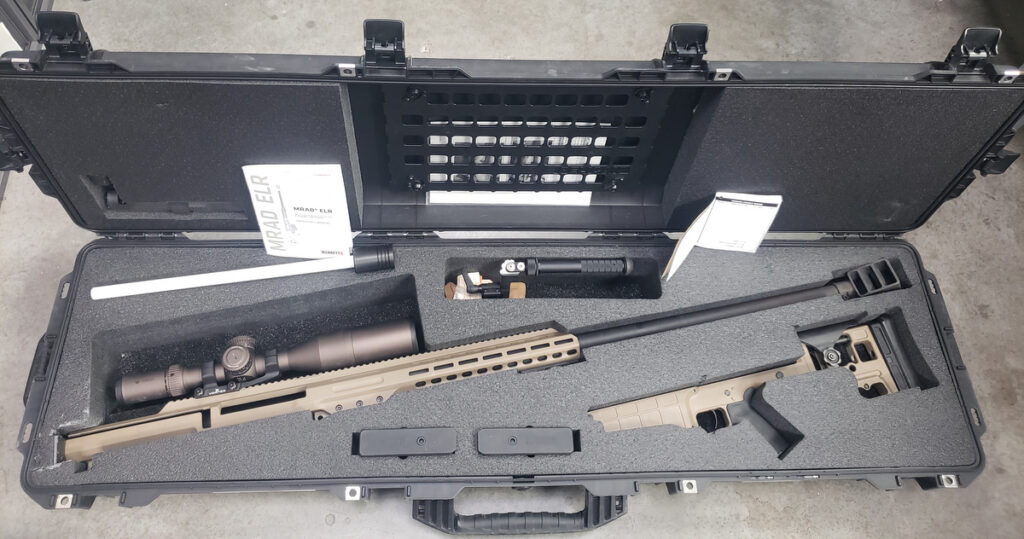
The Barrett MRADELR is in review with SOCOM and other government agencies. SOCOM has its own ESSO program based on the MRADELR in 375 EnABELR, more on that later. Thus, the rifle is still a commercial pack allowing the buyer to choose optics, bipod, etc. Once it becomes accepted, Barrett will offer a new package including accessories specified by the contract.
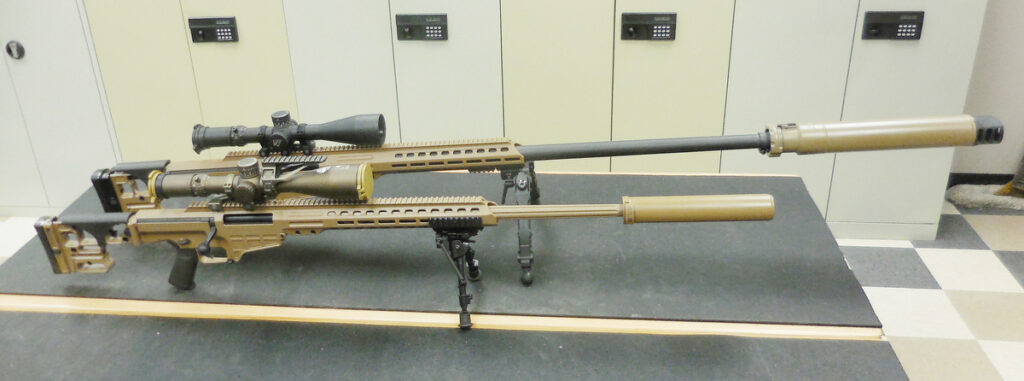
Front, Barrett’s MK22 Mod 0 (MRAD) with AML338 suppressor and Harris bipod. Rear, Barrett’s MRADELR with the QDL suppressor and heavy-duty bipod. Both the MRADELR and the MK22 Mod 0 upper receivers feature M-LOK compatible modular features and a continuous 10 MIL top rail. In this photo, Barrett has installed the excellent NightForce ATACR 7-35mm optic. The front MK22 has the issued custom mount. On the bottom of the upper receiver, visible just in the front of the magwell, are the barrel locking screws. The MK22 (MRAD) has two, while the MRADELR uses three screws to get a longer support area.
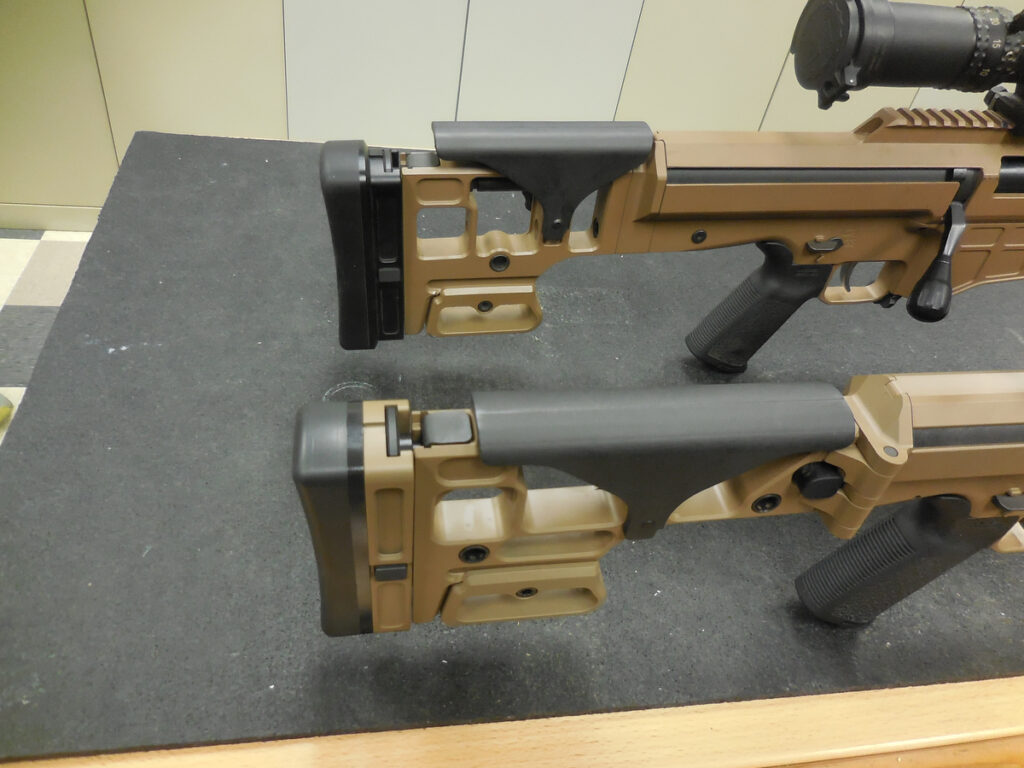
Both the MRADELR and the MK22 Mod 0 feature Barrett’s fixed stock with oversized recoil pad, push-button height adjustment, length of pull, and height adjustable, locking polymer cheek piece. A removable bag rider makes for a very solid back pressure with the offhand, keeping the stock solid to the shoulder.

Rear of the lower receiver, looking down on the takedown pin. The pin is captured and not intended for complete removal. The pin is also blocked from removal if the bolt handle isn’t fully rotated up and is free to slide. This way, the bolt can never be locked up on a live round while the upper receiver is rotated upward.
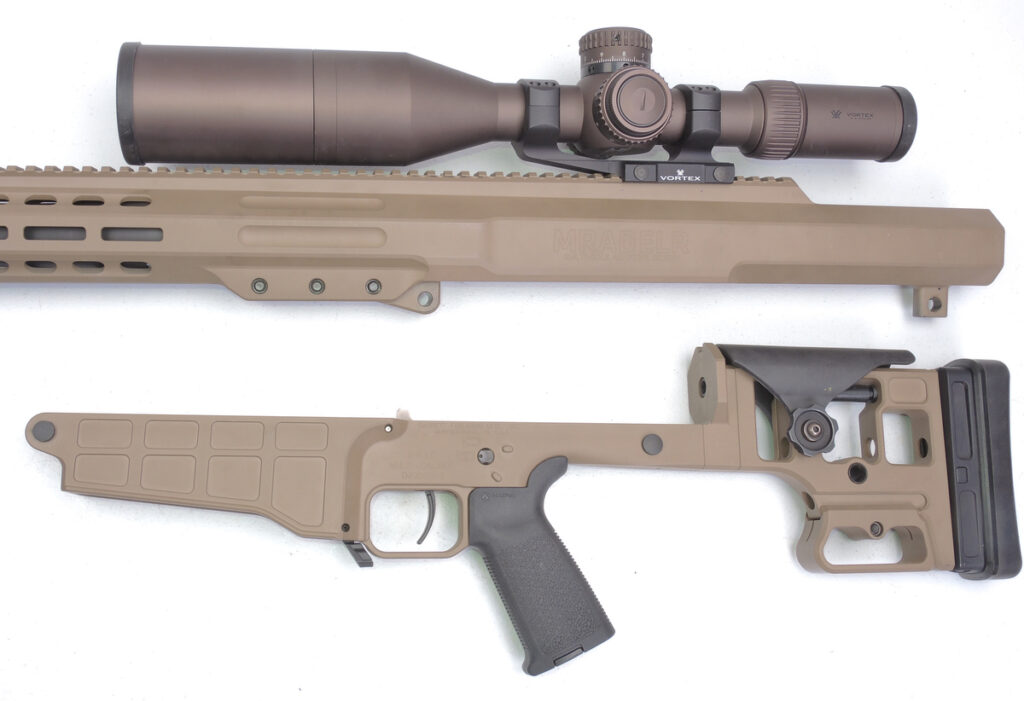
Upper and lower separated; a clear view of how the robust lugs are integrated to support the upper and lower together. The three barrel removal screws are clearly visible at this point. Remember, these are not standard Torx head bolts; they are Torx-Plus and are IP-30 size. Loosen them for barrel removal, but do not remove.


Both the MRADELR (left) and MRAD/MK22 Mod 0 (right) feature Barrett’s adjustable single-stage trigger module which is easily removed without tools. We found both triggers to be smooth and crisp.

MRADELR firing pin, top. MK22 Mod 0 firing pin, bottom.

MRADELR bolt in bolt guide, top. MRAD/MK22 bolt in the bolt guide, bottom. Note the different bolt handles. Parts between the MRADELR and MRAD/MK22 are not compatible.

MRADELR and its bolt guide. The bolt guide removes the metal-on-metal motion/friction and smooths the whole operation, increasing the life of the bolt and receiver channel.
BARREL
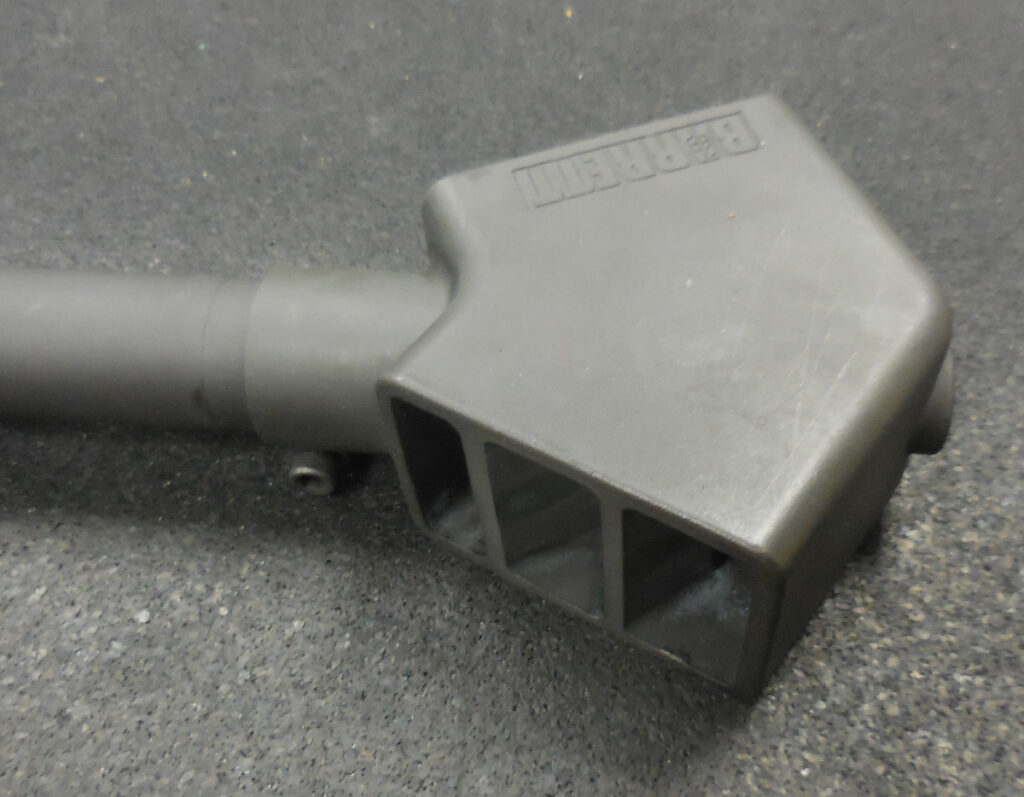
The barrel is a match-grade, single point cut, hand-lapped, stainless-steel barrel and has the famous Barrett 3-port muzzle brake. As shown in the suppressor section below, the barrel is made to accept the Barrett QDL muzzle brake for suppressor use.
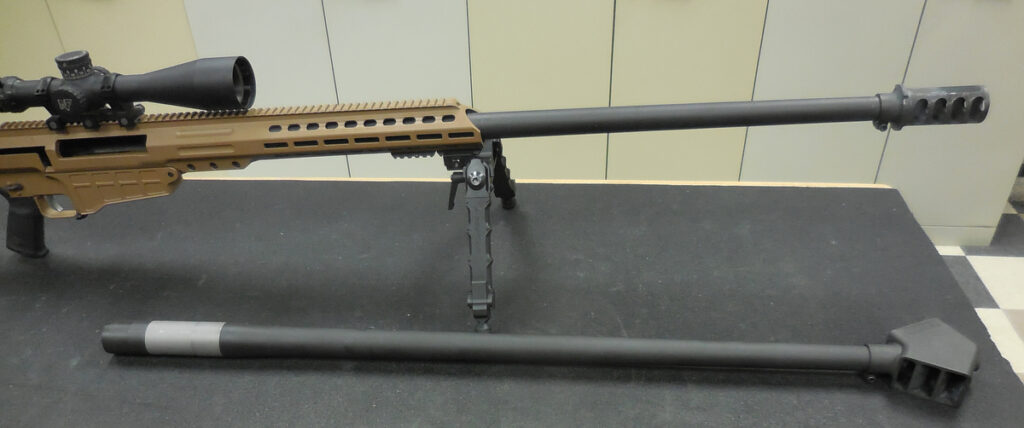
The MRADELR with the shorter barrel and QDL muzzle break installed. On the table is the standard 36-inch barrel. We did not get the opportunity to test it with a suppressor, as it’s not offered as a package yet.

Barrett’s QDL muzzle brake for use with the suppressor, or without.
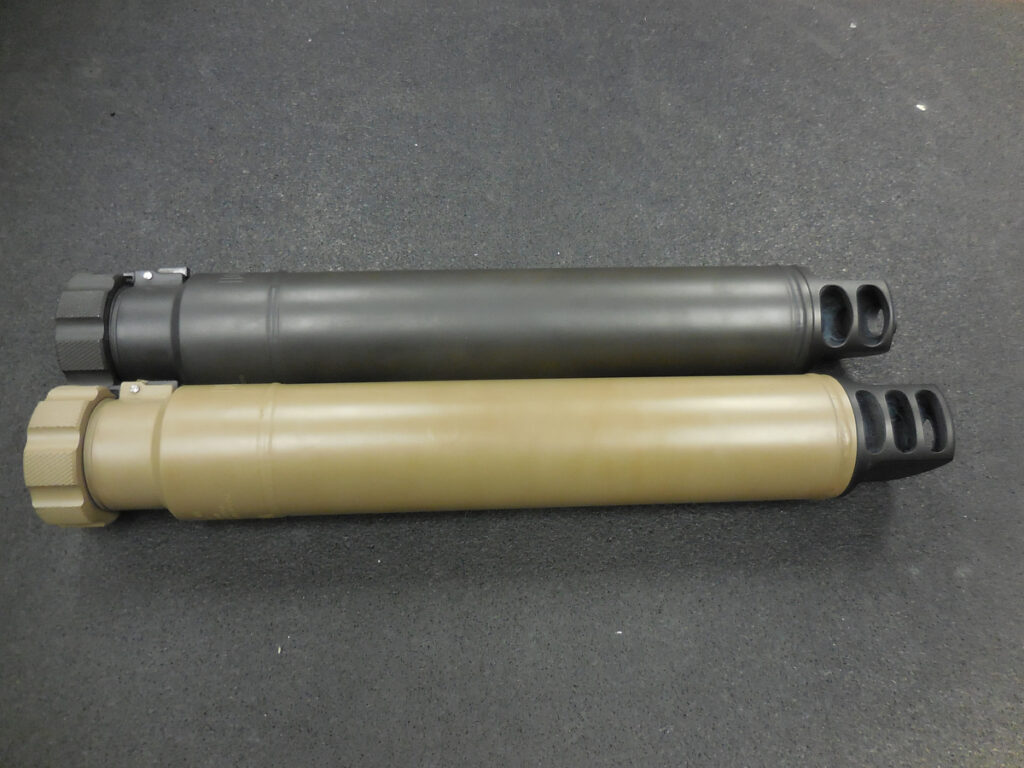
Barrett’s AML338 suppressor, top. Barrett’s QDL suppressor, for larger calibers, bottom.
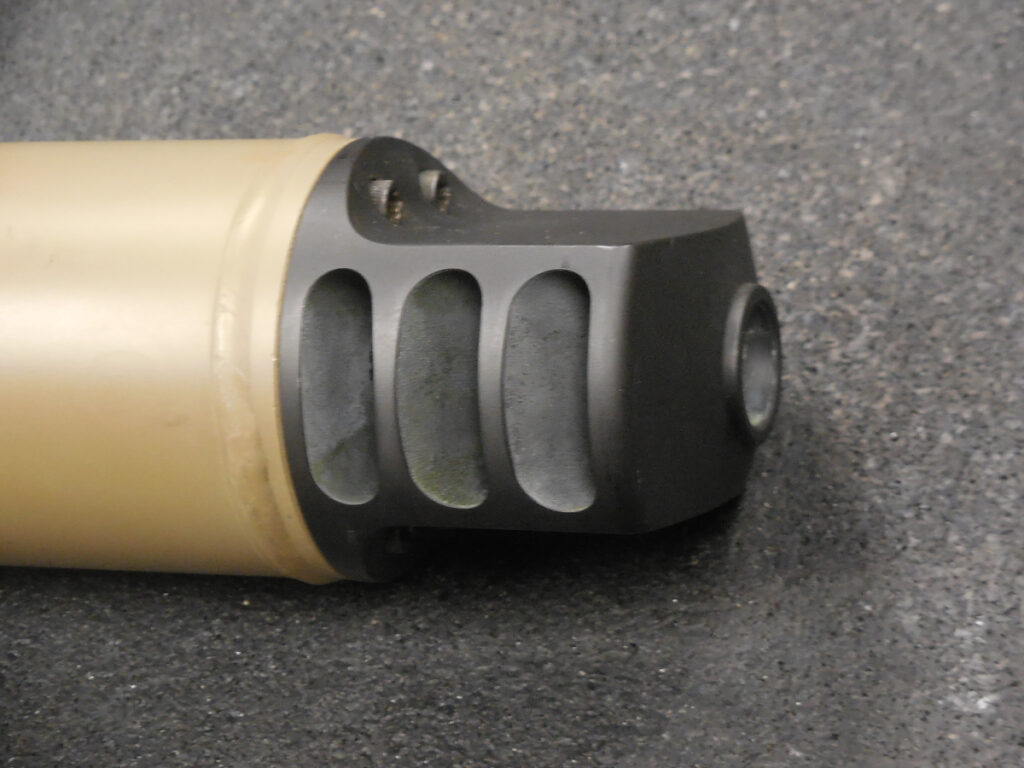
The Barrett QDL for use with the MRADELR has added a third baffle to the exterior stack.
CARTRIDGE
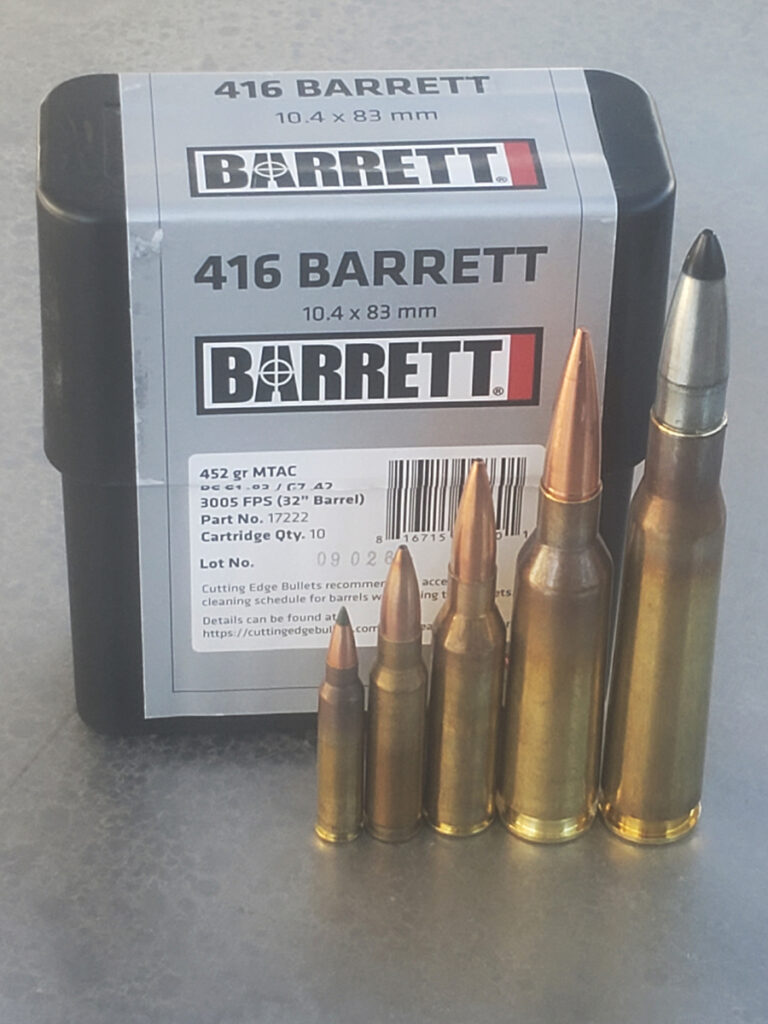
The cartridge: 416 Barrett (10.4x83mm) features a 452-grain MTAC projectile from Cutting Edge Bullets with a BC of 0.83 G1 (0.42 G7) that reaches 3005 FPS from a 32-inch barrel. The ammo we used is part no. 17222 (10 cartridges) lot no. 090265.
For comparison, from left to right in front of the 10-round Barrett case: 5.56x45mm Black Hills 77-gr Tipped MatchKing, Black Hills .308 Match 175-gr BTHP, Black Hills 338 Norma Magnum 300-gr OTM; 416 Barrett 452-gr. MTAC, RUAG 50 BMG HC SX Sniper.
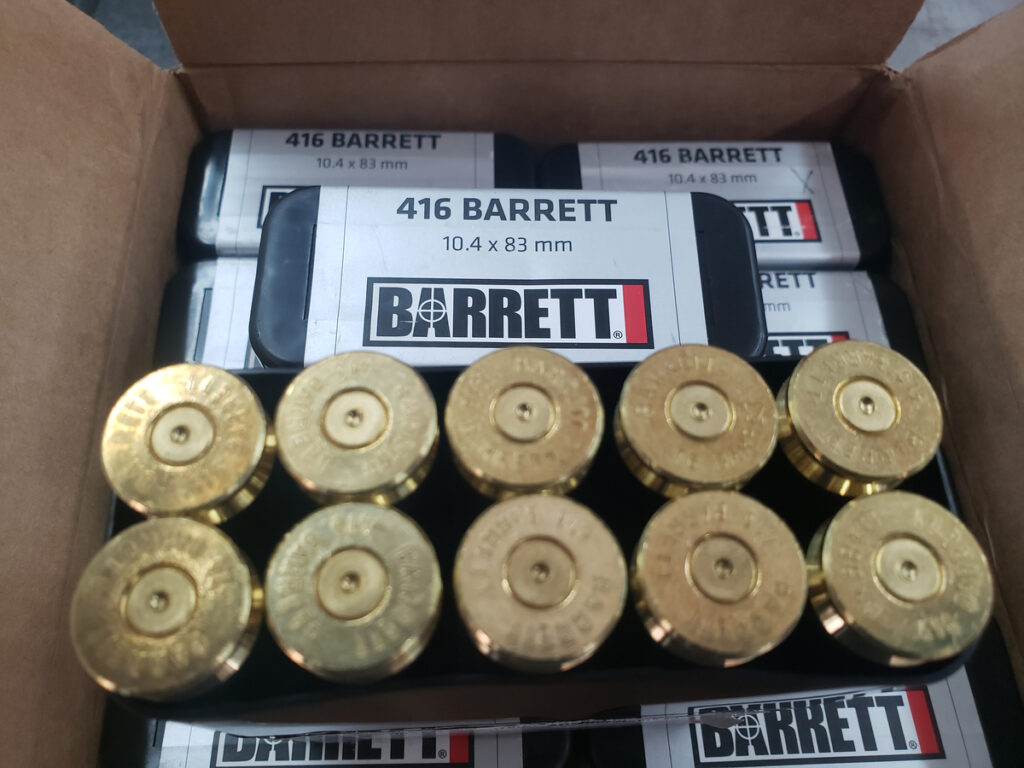
Always read the brass: We’re pleased to note that we found no issues at all. No excess gas bleed-by and no primer creep or swell. In fact, every firing pin hit was solid and consistent. Good signs.
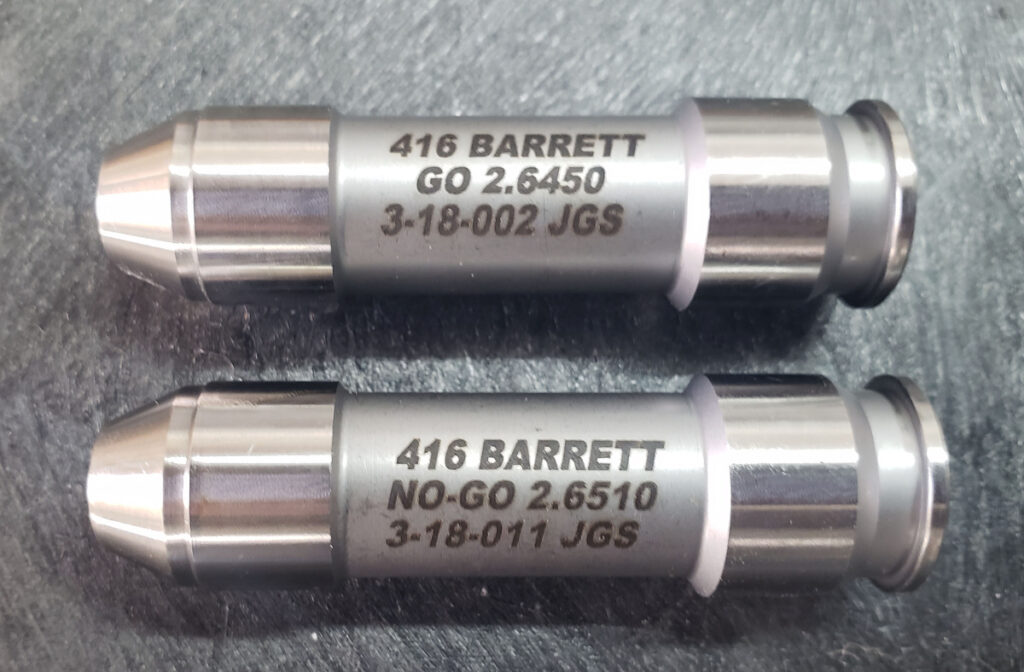
Barrett’s engineers specified a set of go-nogo gauges early in the development of the 416 Barrett cartridge. Barrett sells these gauges, and if you are getting into the extreme long range firing community, we highly recommend getting a set.
MAGAZINE
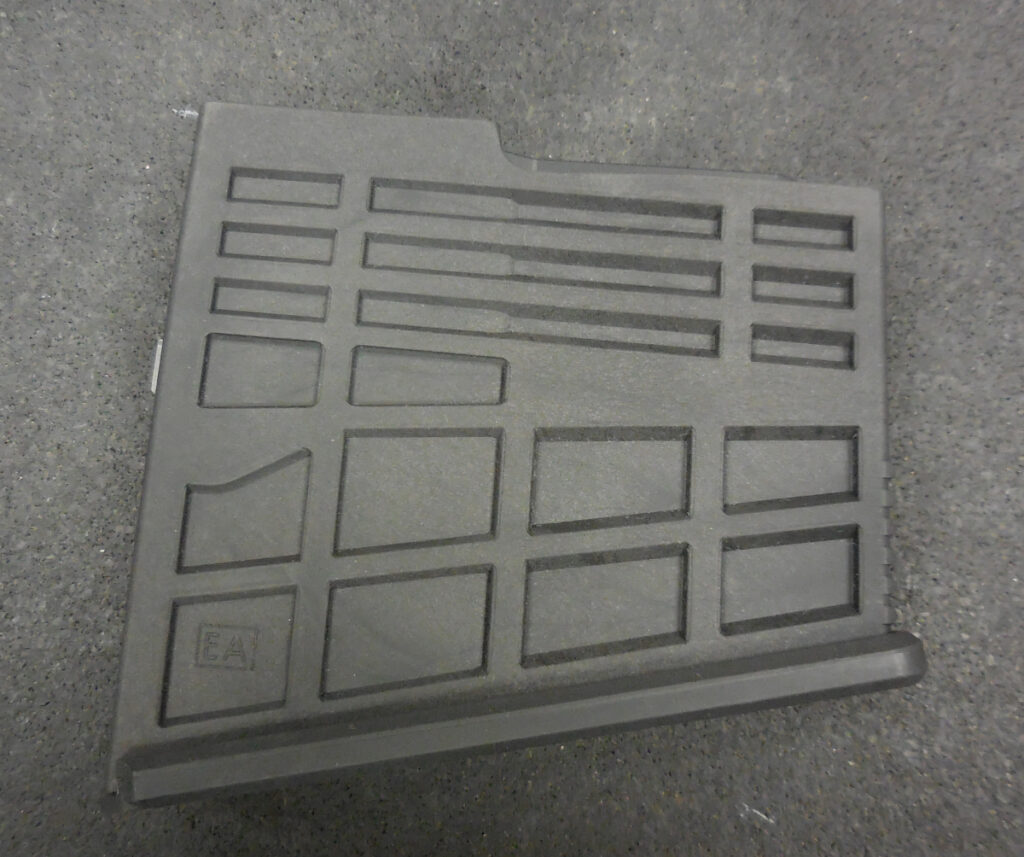
The MRADELR 416 Barrett 5-round magazine, right side. Long-time readers of our magazines will know that we pay a lot of attention to feeding devices. Many times, this is the most difficult part of designing a firearm; feeding it reliably. Barrett’s engineers have a long history of dealing with this challenge.
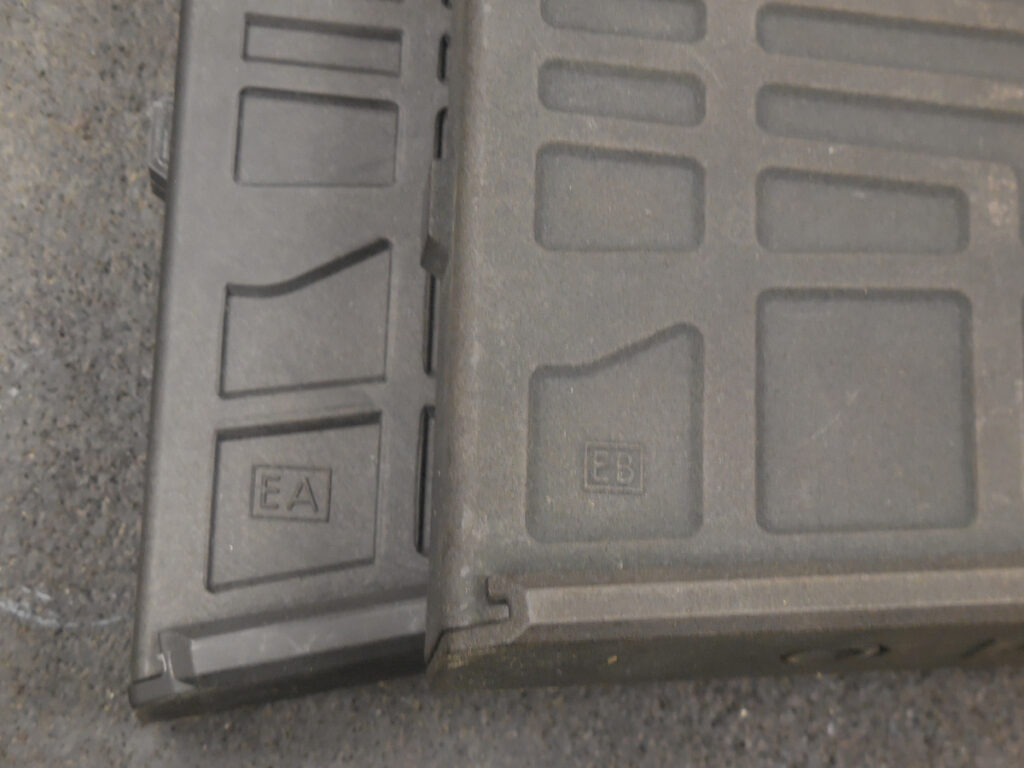
Important note: the 416 Barrett magazine has EA marking, the 375 EnABELR has the EB marking. The bolt head, barrel, and firing pin all have similar markings to denote which is the caliber. These parts are not interchangeable, they’re caliber specific.
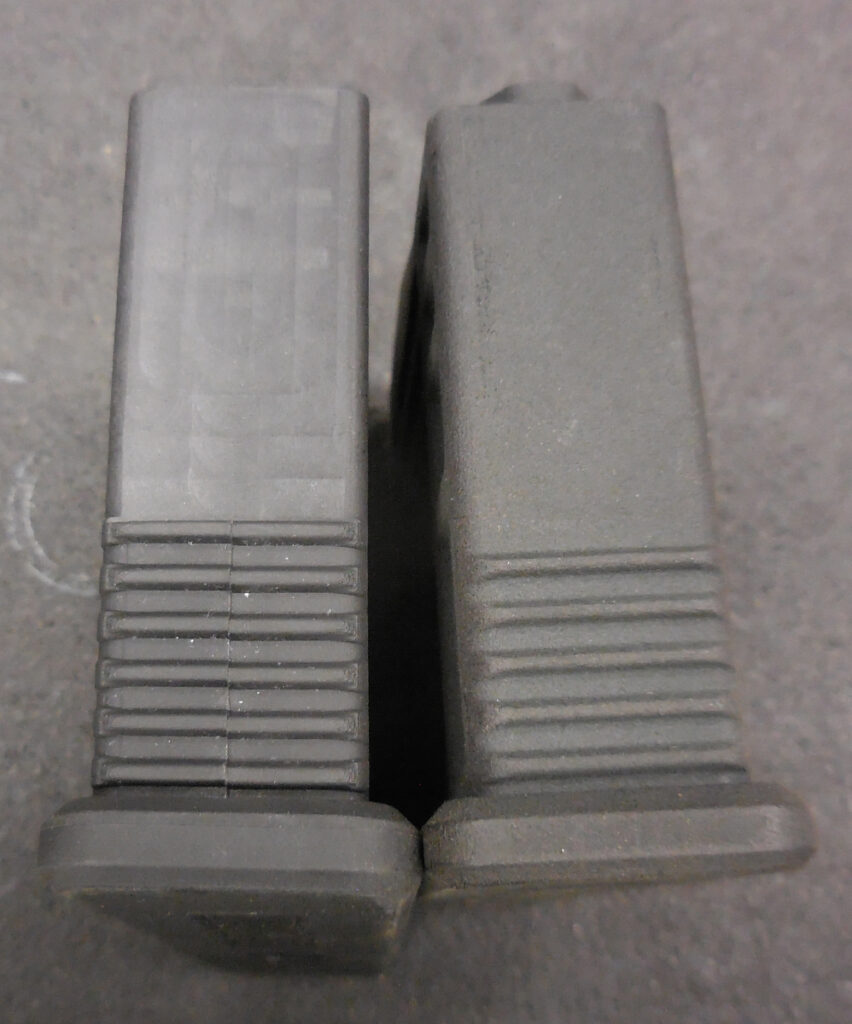
Similar to the identification of the MRAD/MK22 Mod 0 magazines, there is a tactile group of ridges on the front of the magazine for blind identification of the magazine you’re reaching for. The 416 Barrett cartridge MRADELR magazine has six ridges on the front, the 375 EnABELR magazine has five
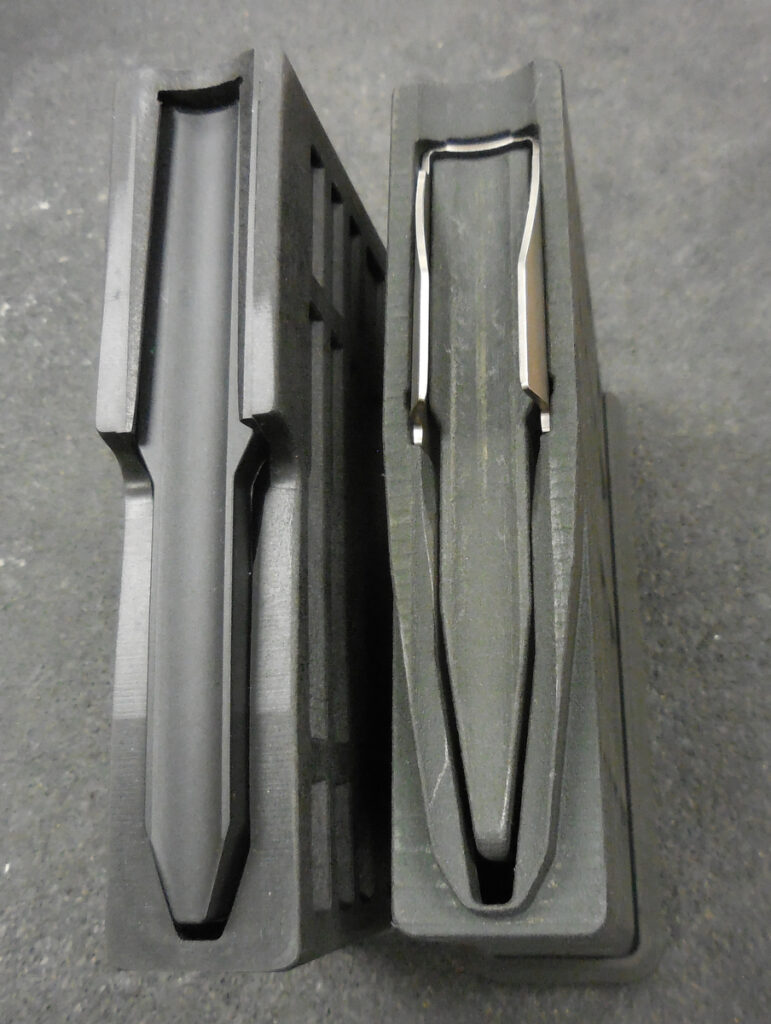
View of the magazine feed lips. MRADELR 416 Barrett on the left, ESSO Program magazine, 375 EnABELR on the right.
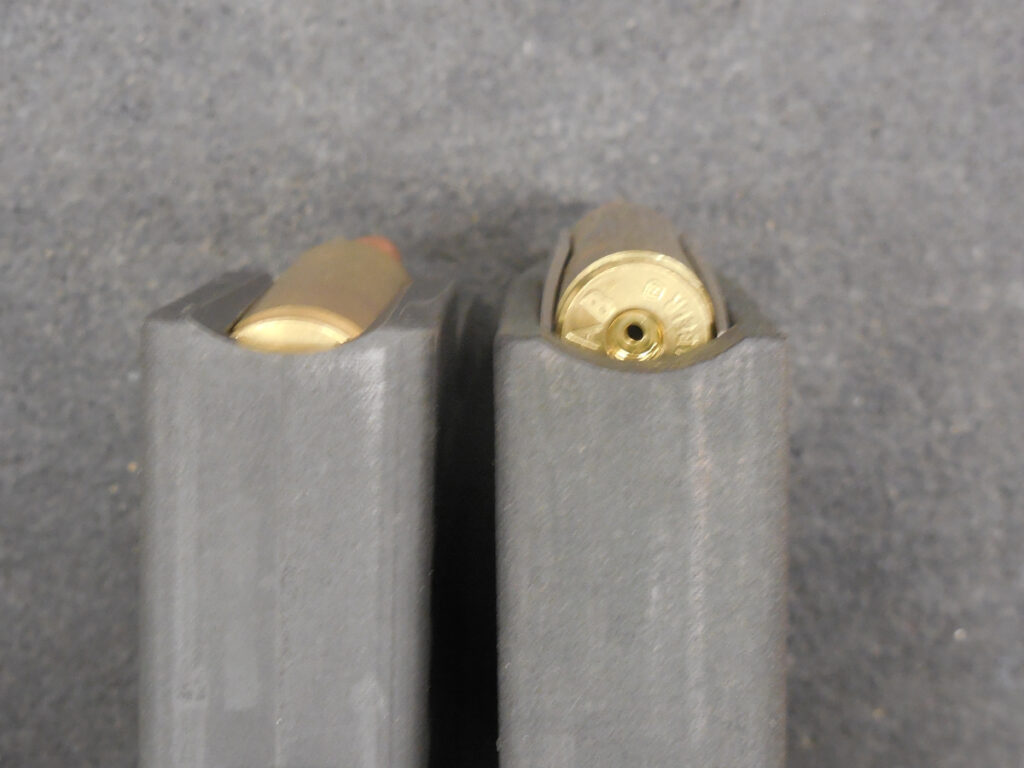
At left, the MRADELR 416 Barrett round presentation. At right, the MRADELR (ESSO Program) 375 EnABELR presentation must be higher. Thus, the more complex feed control lips. Rear view of the magazines. MRADELR in 416 Barrett magazine, ESSO Program 375 EnABELR magazine. There are feed issues with the 375 EnABELR cartridge in an MRADELR that need to be addressed with a higher presentation and more control of the rounds.
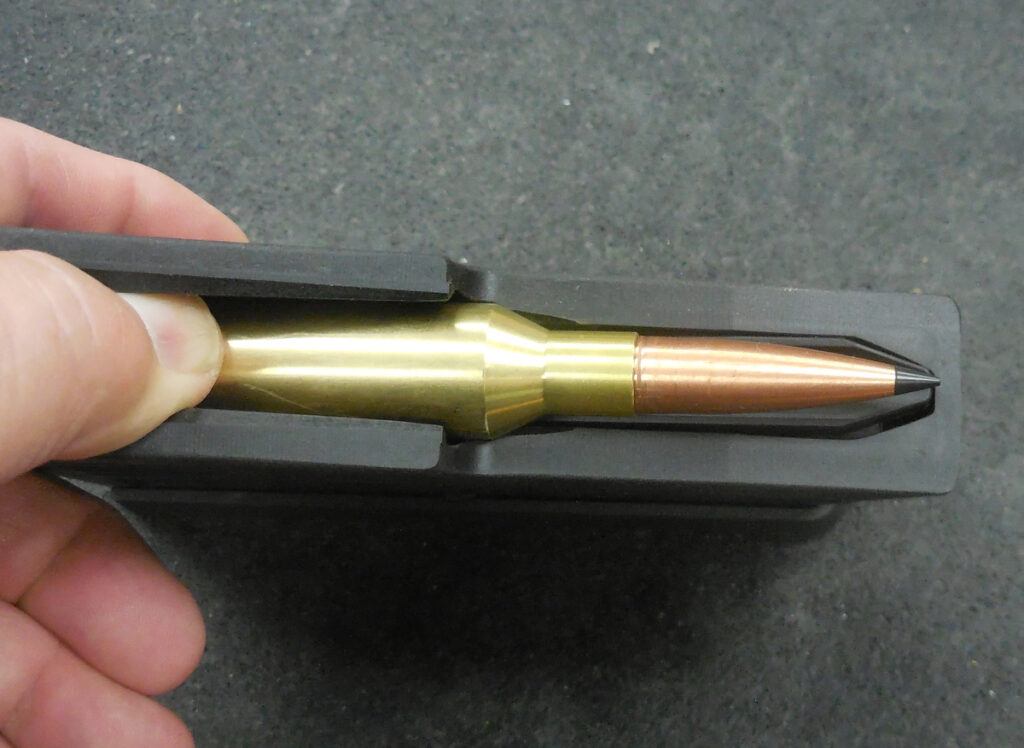
Note the presentation of the cartridge. There is support at the neck of the cartridge. This is to avoid pressure on the front of the bullet which can cause accuracy issues. Holding the cartridge at the neck area is just one more attention to detail Barrett’s engineers plan, as well as a longer cartridge area for special loaders to use different projectiles.
BOLT
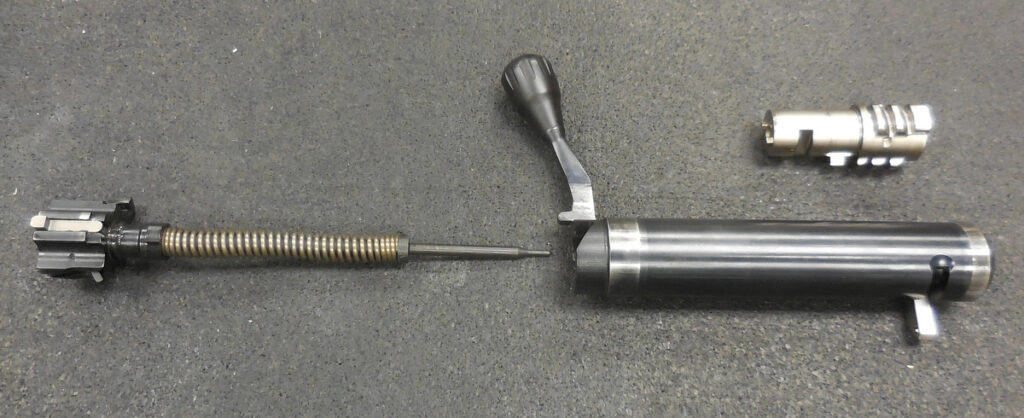
The MRADELR bolt, basic disassembled, showing firing pin assembly, and bolt head assembly. The MRADELR bolt head is removed by rotating the bolt lock to the open position, as shown, and the bolt will rotate forward and out. The bolt is electroless nickel plated for reduced wear, cleaning, and inspection, as well as the added corrosion resistance.
OPTIC


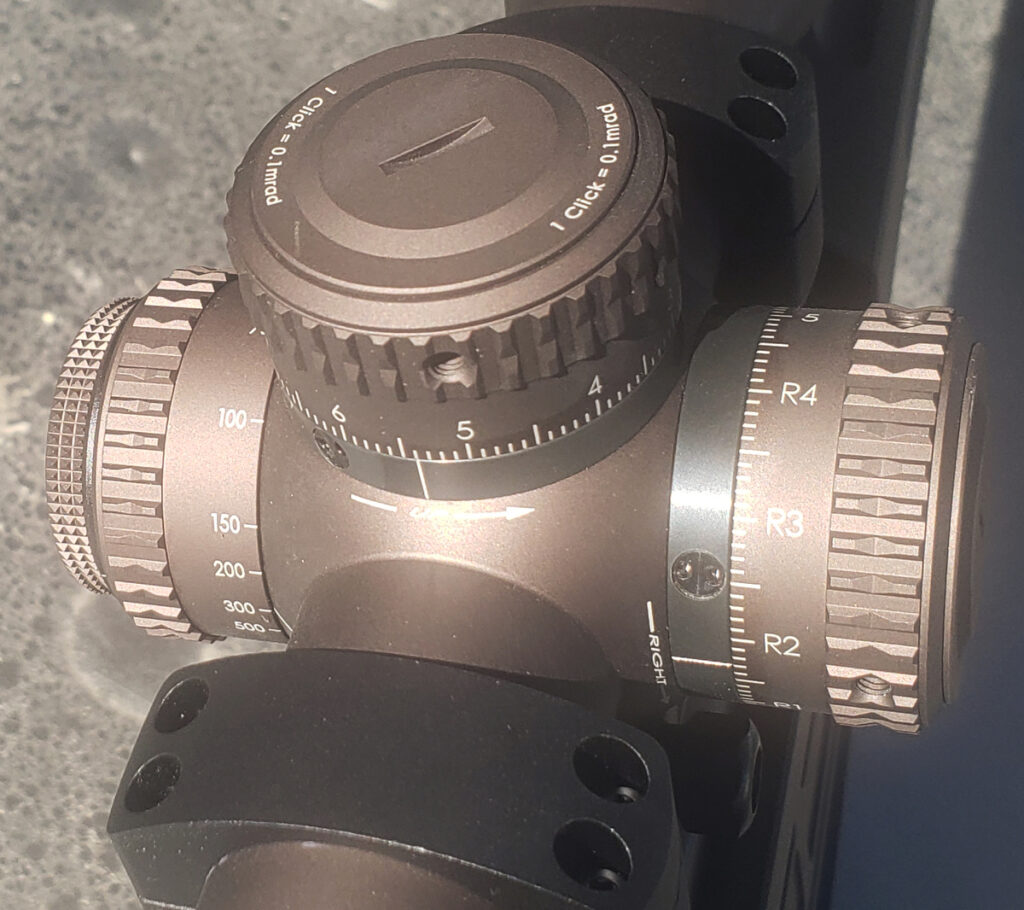
We’ve used the Vortex RAZOR HD series in other tests in the past. In this case, we chose the Vortex RAZOR HD Gen II in 4.5-27×56. It’s a superb scope. We chose the EBR-7C MRAD reticle, it’s a flagship reticle for Vortex, and it was crisp and clear out past 1100 meters (and beyond, we just didn’t have targets that far out.) The MRADELR has a 10-MIL rail, and there’s technically 120 MOA built into the scope. So, going for the longer ranges made the choice for us. This is a first focal plane (FFP) scope, our preference for this type of shooting.
Notes from an end user: During this test, out in the desert, there is a significant amount of mirage. One of the reasons we wanted to try the 27x optic (and not go much higher) was some recent experiences at longer ranges where the mirage interfered with placement at high magnification. This has always been an issue with scopes, but the RAZOR HD Gen II’s clarity was excellent. Second, seeing into shadow at range. When you get to 600 to 1000 meters, any tree line or shadow area on a mountainside becomes a problem. Many scopes I’ve used give a flat image of the darkness. The lens coatings used by Vortex, along with the quality of the glass, allow me to see into the shadows, giving a more three-dimensional view. There are many scope manufacturers, a few that I like, but for this type of shooting I tend to favor the Vortex RAZOR. It’s also FFP, which I prefer, as well. It’s got a great field of view, the hashmarks are fast for me to use at higher magnifications, and make my adjustments.
BIPOD
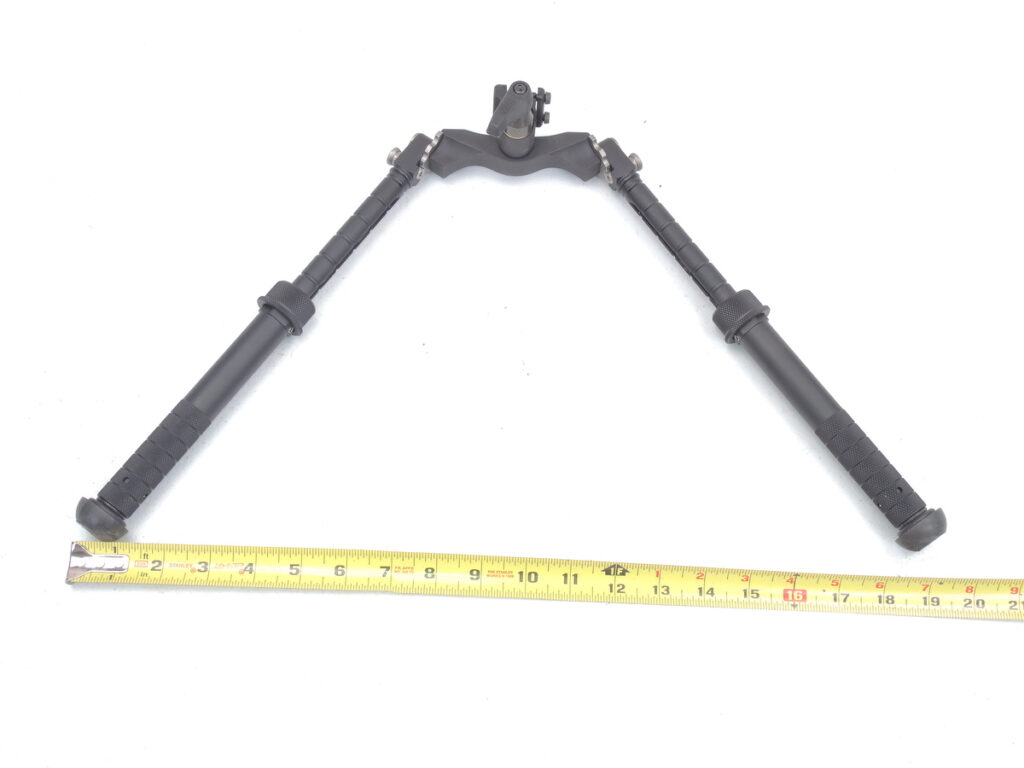

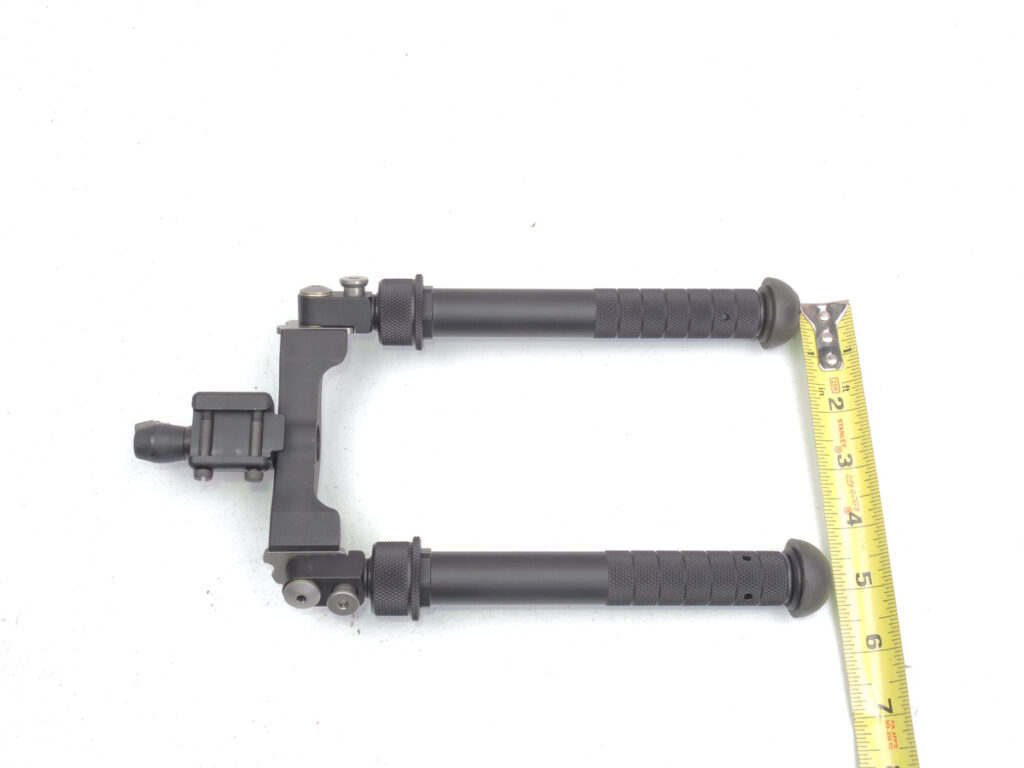
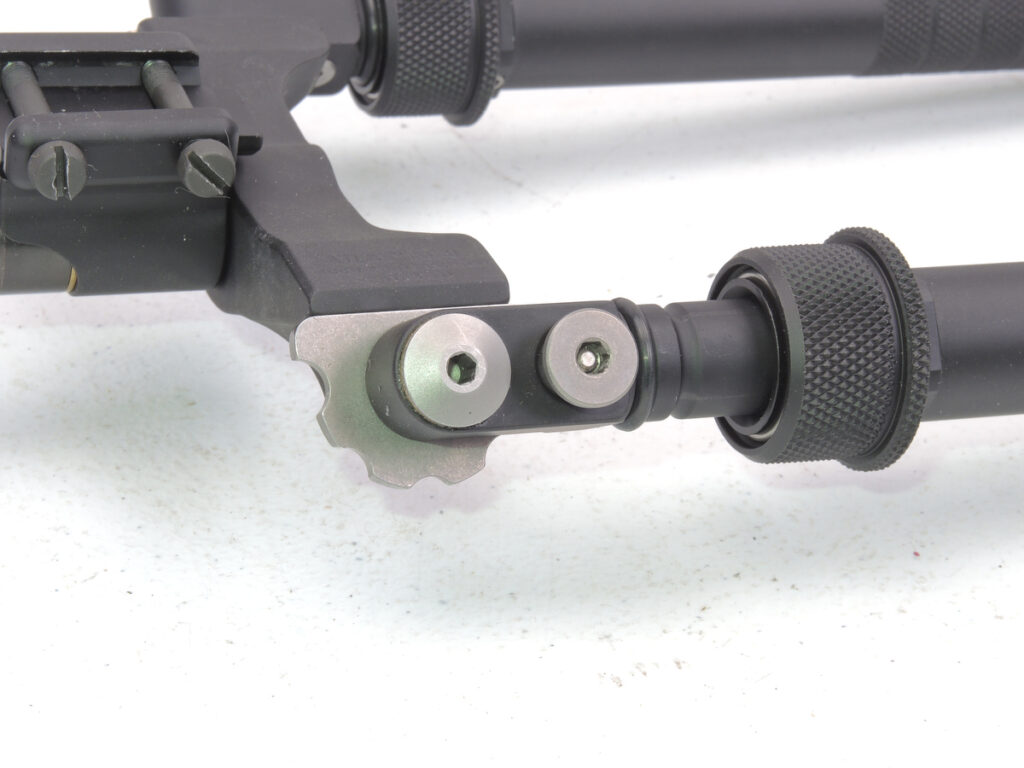
Bipod support on such a long-range caliber requires a much wider footprint than smaller calibers. This is verging on blending bench-rest technologies with a standard military support. Barrett suggested three different bipods and we chose the ATLAS BT72 Super Cal Bipod with a 1913 Pic rail mount. It was a very good choice. The footprint spreads from 14.75 to 19.37 inches, giving an elevation range to the rifle base of 5.8 to 11 inches. Perfect. It’s constructed of 6061 T6 aluminum with a Type III mil-spec hard anodizing. There is a 45° pre-tensioned cant that we found excellent for setting in with a nice, stiff lock position. The leg positioner is heat-treated stainless steel. The springs and fasteners are also stainless. The legs do not rotate (a huge plus for stability) and lock at 0, 45, 90, 135, and 180 degrees. www.accu-shot.com
Before we go to the Range, there are some specific items that are needed to assist in ELR shooting. Range-finding, spotting, and environmental data are critical. These were our choices:
ATMOSPHERICS

Kestrel 5700 Elite Ballistics Weather Meter from Kestrel Ballistics and the Kestrel Drop D3 Wireless Environmental Data Logger are two essential range and field accessories. The Kestrel 5700 Elite has a full ballistics calculator onboard, it’s a seriously accurate scientific instrument that fits in your pocket. The windmeter is protected from damage with a rotating cap. The fact that Kestrel knows the operator will need quick spot checks and makes that fast and easy is a big plus. We did our full prep then the spot checks. The 5700 Elite & The Drop are LiNK enabled for Bluetooth coms with your phone or tablet, have an “Easy Mode” for quick adjustments, & can store 30 custom rifle and ammunition profiles. The maximum range Elite can work at is 5500 yards, so it’s perfect for our purposes.
RANGEFINDER
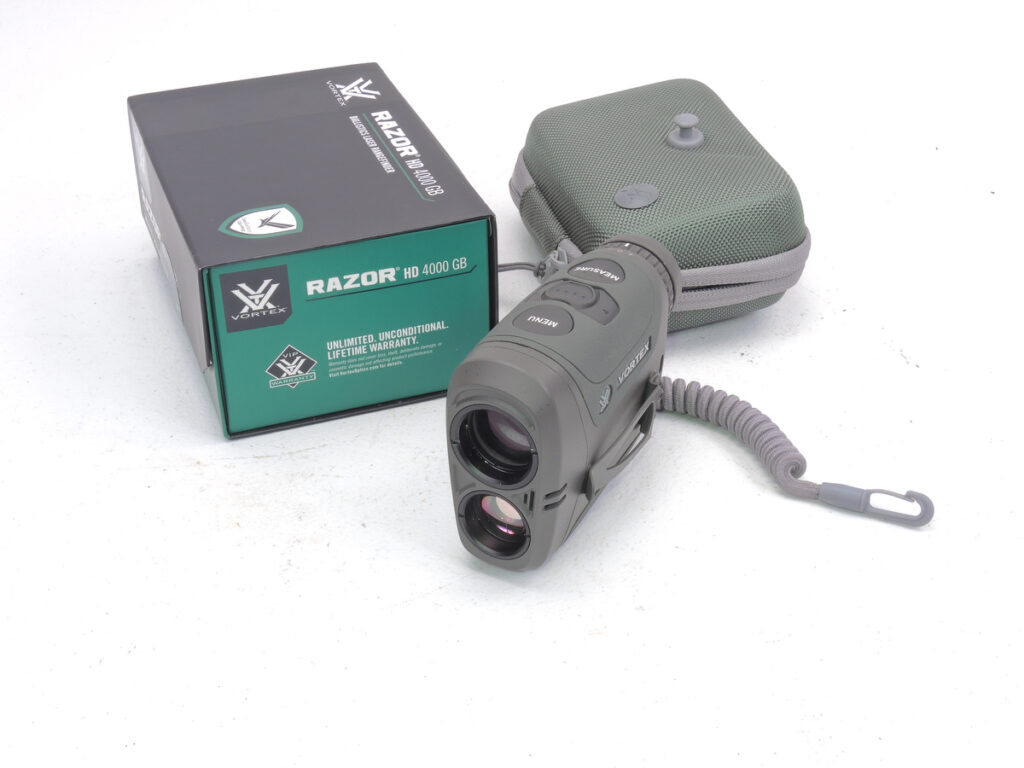
Getting true ranges for accurate shooting is not as simple as using the basic $200 range finder. At 4000 meters, stability and accuracy of the laser are as critical as is the reading. We chose the Vortex RAZOR HD 4000 GB laser range finder for a variety of reasons. The first is the legendary accuracy of this range finder. Vortex has decades of experience, and their top-of-the-line HD 4000 performs to the level we needed. The HD 4000 GB pairs with the Kestrel meters. Combined with the Kestrel 5700 Elite, we had the most accurate environmental and range finding capabilities possible at our level of civilian ownership. We’re going to explore this more at other times. The possibilities are staggering.
SPOTTING SCOPE
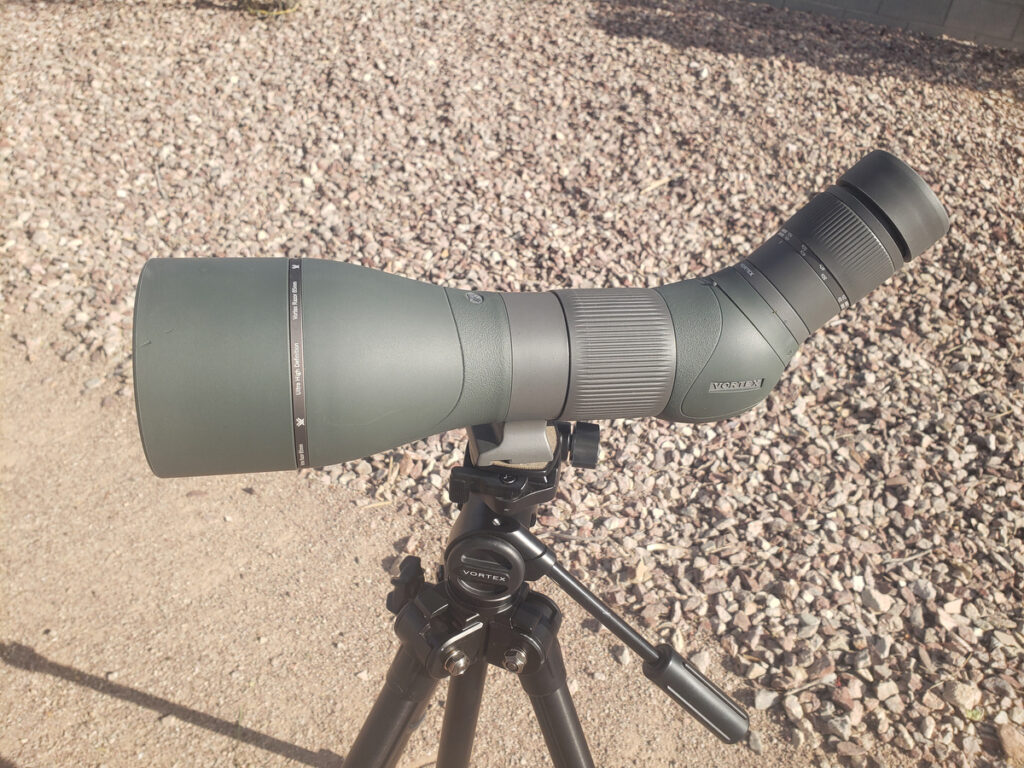
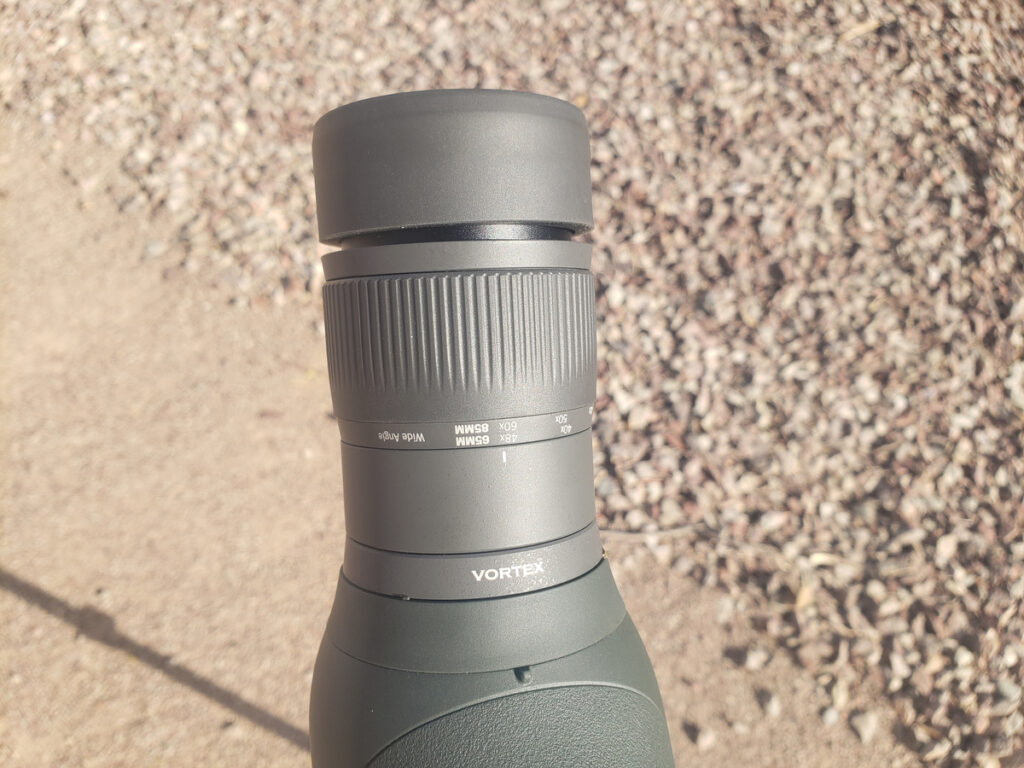
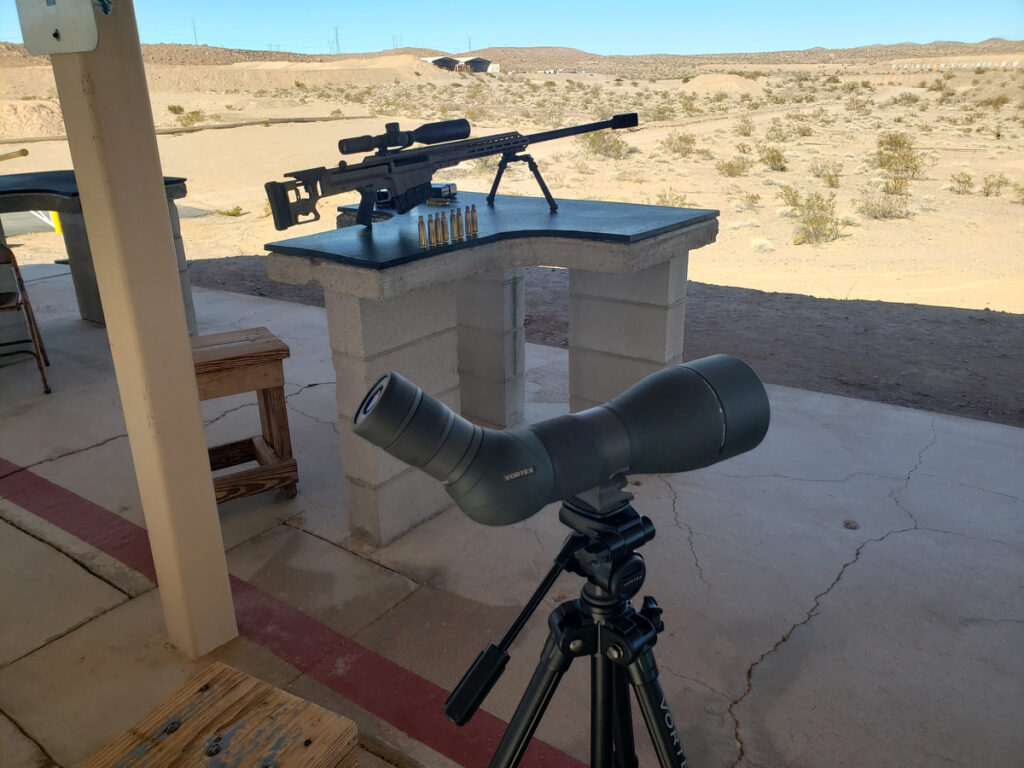
Our spotting scope is the Vortex RAZOR HD Angled 22-48×65 on a Vortex tripod. The same optical characteristics that we like in the RAZOR scopes are in the spotter. There is excellent depth of field, penetration into shadows, and an almost infinite series of adjustments to get clarity on a target. We did not get a chance to use this on 2-mile targets, but at 1100m (our range limit) the spotter was able to call shots perfectly every time. They claim a linear field of view of 117 to 68 feet at 1000 yards, we found that was quite clear and adequate at our ranges. Ours came with both MOA and milrad eyepieces, which we could change out to match which optics we were using. This is very handy for the spotter calling in shots.
ON THE RANGE
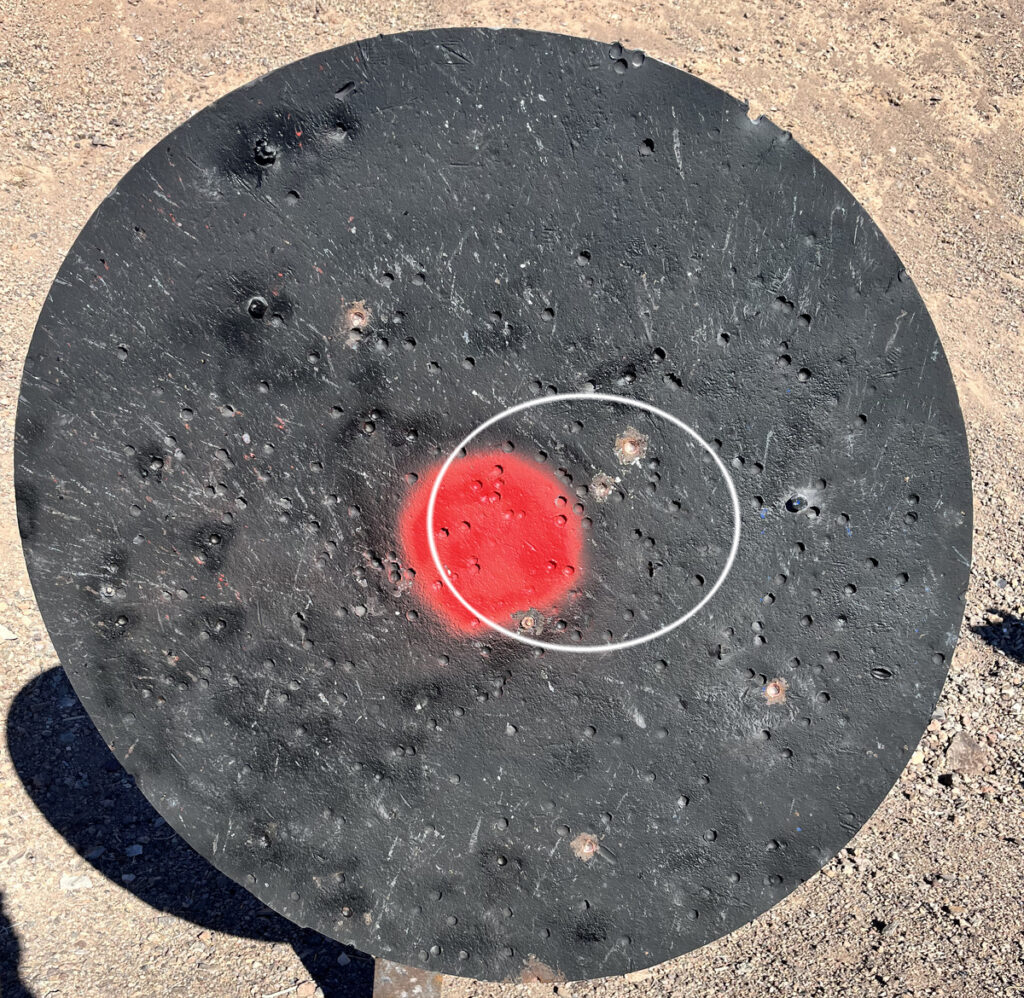
Preparing to fire at the range. We’re at the long-range rifle range at the Boulder Rifle & Pistol Club, an excellent range. There are measured targets out to 1100m with special accommodation out to one mile on a newly measured range area that was not yet open, so we were working with targets at a maximum range of 1100m.
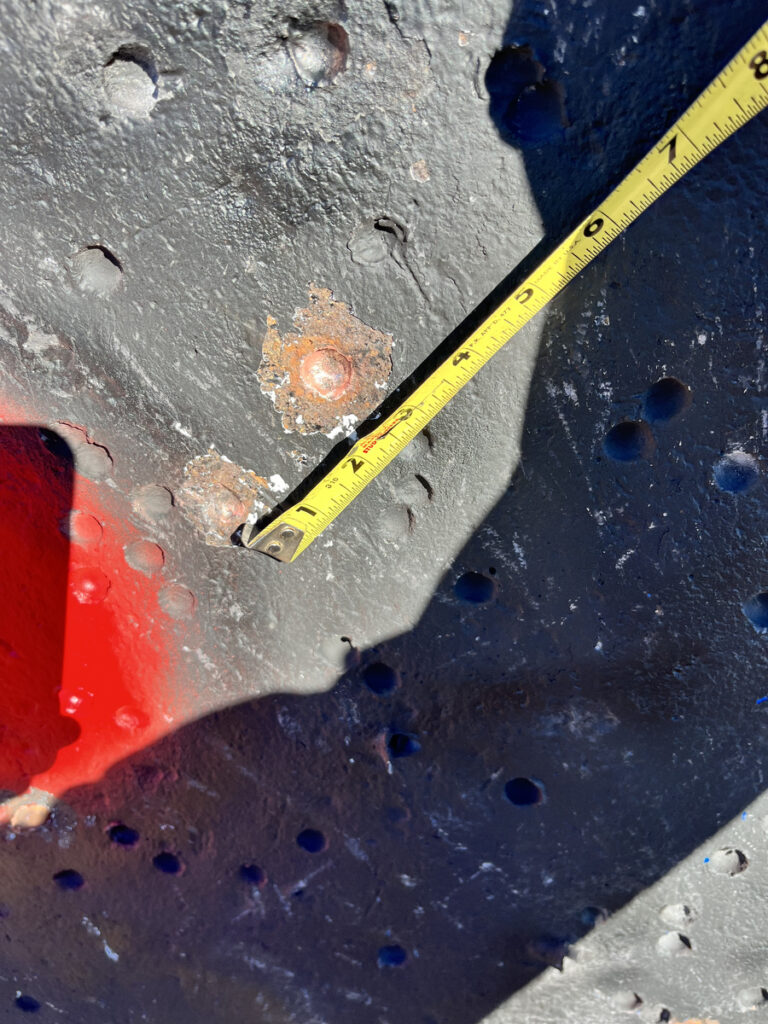
Our sighting in at 100m was fast and, honestly, a bit useless because the optic needed to stretch its legs a bit. We switched to 200m, then 500m. Groups were consistently dialed in under 0.5 MOA. At 900m about 0.38 MOA. Dennis Powell was our long-range shooter on these targets. It’s been difficult to get the MRADELR away from him. At 1100m on the full target, you can see where he walked to get to the center and was still a bit high at two o’clock. Two rounds went into less than 3 inches, the third is lower down at about 5 inches. That’s under 0.5 MOA at 1100m. This is enough to convince us of the solid accuracy of the MRADELR sniper system and the 416 Barrett cartridge.
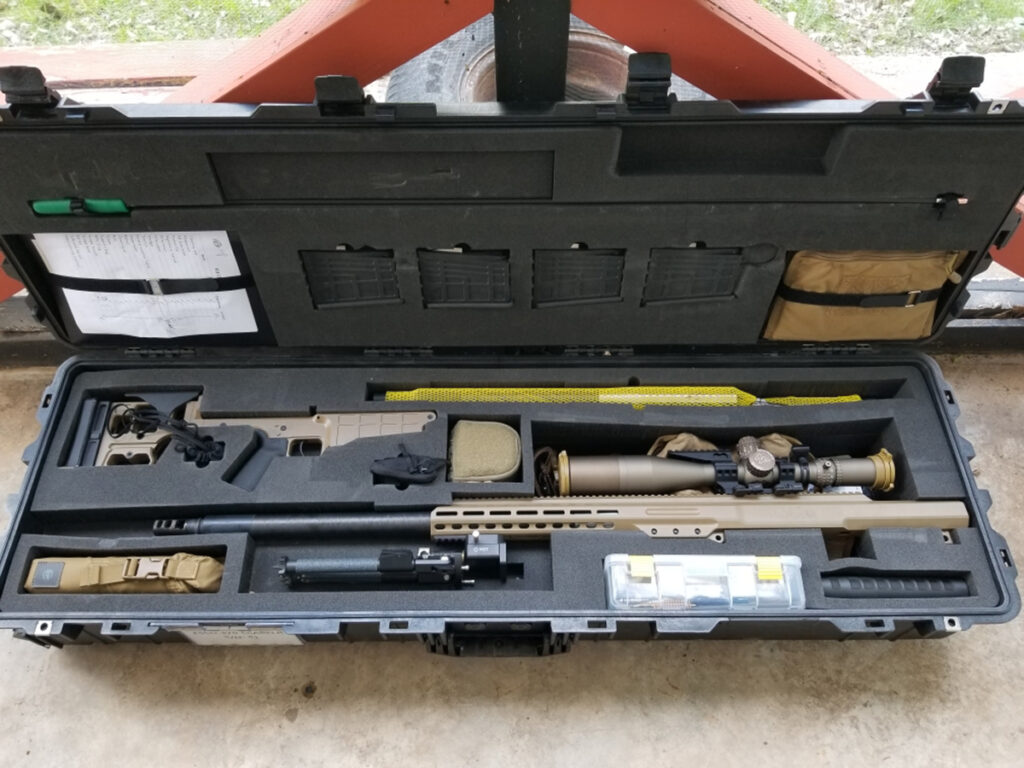
Bryan Litz of Applied Ballistics, the 2019 winner of the NDIA Gunnery Sergeant Carlos Hathcock Award for contributions he’s made to our military snipers and their capabilities, has a contract on what is called the Extreme Sniper Strike Operations (ESSO) program. The ESSO candidate is an MRADELR in caliber 375 EnABELR (was ELR) for ranges over 2000m (Litz designed the cartridge) and has a carbon-fiber wrapped barrel, a SureFire suppressor, and a NightForce ATACR 7-35 as part of the program. Trials are still happening. This is a picture of the proposed sniper package. SADJ has made arrangements with the involved government agencies to do a test in the near future.







